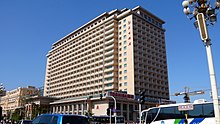Beijing Hotel



The Beijing Hotel (
Overview
The first wing of the Grand Hôtel de Pékin, a five-story red brick structure, was completed in 1915.
A new wing was added on the west side of the 1917 wing of the Beijing Hotel in 1954, it is today known as Block C.[2] The original red brick 1915 wing was demolished for the construction of Block D, on the east, in 1974.[2] At 89 meters, the tower was the tallest building in Beijing at the time. Finally, Block E was built directly behind the 1917 wing in 2001.[2]
The hotel complex today operates under three separate names. In April 2005,
The hotel usually caters to foreigners and wealthy domestic guests, providing restaurants and bars in a Western and Asian style.[6] Various members of state have stayed there, including Richard Nixon, U Nu, Nikita Khrushchev, Ho Chi Minh and Sun Yat-sen.[4][7] The hotel has been awarded the Five Star Diamond Award for consecutive years. During the 2008 Summer Olympics and the 2022 Winter Olympics, the hotel served as the headquarters of the International Olympic Committee.
Significance
Many foreign journalists were based in the hotel during the spring of 1989. This was the site where
See also
Gallery
- Beijing Hotel
-
Beijing Hotel, Block D
-
Beijing Hotel NUO, Block B
-
Beijing Hotel NUO, Block B
References
- ISBN 978-0-8476-9318-4.
- ^ a b c d "Beijing Hotel Official Website". Archived from the original on September 3, 2011.
- ISBN 978-1-74059-782-1.
- ^ a b c Official website History
- ^ "Raffles Beijing Hotel to Be Renamed Beijing Hotel NUO". www.hotelnewsresource.com.
- ISBN 978-0-631-23093-9.
- ^ Ren, Feng (December 19, 2019). "北京这座神秘的大楼,普通人进去走一圈就能改变命运" [In this mysterious building in Beijing, ordinary people can change their fate by walking around]. Zhihu (in Chinese). Retrieved 2023-01-26.
- ISBN 978-0-226-98261-8.



